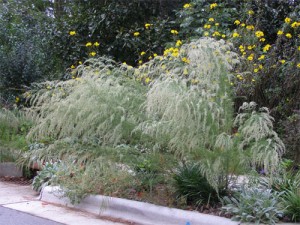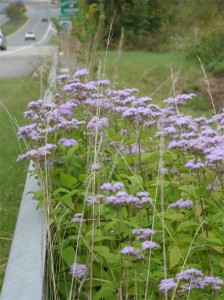Eupatorium’s many shades and shapes
By Ken Moore
Eupatoriums have been featured in past Flora columns. Joe-Pye weed, Eupatorium fistulosum, that tall mid-summer, dome-shaped, butterfly-covered, pale-purple-flower-headed roadside one comes immediately to mind. Then there is the recently described flat-topped, white-flowered, boneset of medicinal fame; remember, the “perfoliate†leaf one, E. perfoliatum?
Well now, I’m not going to try to describe the two dozen or more different species of Eupatoriums growing throughout our state, but there are two that can easily catch your attention now along our roadsides.
First, let me comment a bit on the official name, Eupatorium (yew-pat-OR-ium). It’s from the Greek and commemorates Mithridates Eupator, King of Pontus, who is credited with the discovery that one species was an antidote against poison.
Perhaps it was one similar to our own boneset. So there you have a tidbit about the genus name for this group of wildflowers (call them weeds if you dare) that are a part of the large aster or composite family of plants.
Challenging you regular Flora readers, remember the flower characteristics of the aster family? The flowers are really tight clusters, heads, of tiny flowers in configurations of disc (tube) flowers in the center surrounded by a circle of ray flowers, like Black-eyed Susans, or heads of all ray flowers, like dandelions, or heads of disc flowers, like Joe-Pye weeds.
Eupatoriums are characterized by flat-toped, dome-shaped or other various-shaped clusters of hundreds and hundreds of heads of tiny disc flowers. You will want to devote at least a few minutes, if not half an hour, for a Eupatorium conversation at your next dinner party.
For a couple of weeks now, I’ve been admiring a misty purple flowered clump of E. coelestinum (see-less-TY-num) protected from mowers by the guardrail along the bypass crossing Smith Level Road. The species name, appropriately, means heavenly or sky blue. The common names include mistflower, blue boneset and ageratum, the latter likely familiar to most of us. Perennial ageratum has been passed along from garden to garden for so long that it is generally considered an escape from cultivation rather than the native it is. It’s fun to see it occurring in moist fields and roadside ditches this time of year. Next time you see it, take a closer look and try to count the number of disc flowers in a single head.

Volunteer dog fennel is a show-off in front of swamp sunflower in Diana Steele’s wild curbside garden. Photo by Ken Moore.
The other Eupatorium of note is E. capillifolium, the weedy dog fennel of pastures. The species name refers to the capillary-thin, thread-like leaves that make the whole plant look like a kid in need of a barber. Head-high perennial stems, gracefully waving thousands of dusty white to pale-burgundy disc flowers, may go unnoticed when growing so plentifully in fields, but a single plant in a garden border can be a real knockout. The volunteer specimen dog fennel in Diana Steele’s wild curbside garden on Mason Farm Road is worth a drive by.
While the merits of ageratum are mainly aesthetic, the merits of dog fennel are enhanced by a heritage of Native-American medicinal use. I’ll leave it to you to seek out some details from the Herbal Remedies of the Lumbee Indians or James Dukes’ Handbook of Northeastern Indian Medicinal Plants. I’m not certain I would use the new information for dinner table conversation, but I’ll forever admire dog fennel with greater appreciation.



Comments are closed.